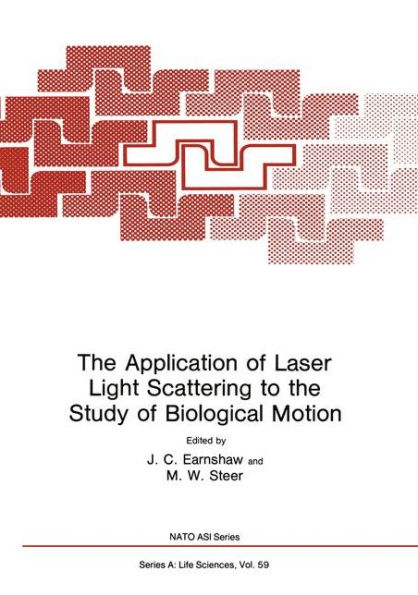5
1

The Application of Laser Light Scattering to the Study of Biological Motion
705
by J. C. Earnshaw (Editor)
J. C. Earnshaw

The Application of Laser Light Scattering to the Study of Biological Motion
705
by J. C. Earnshaw (Editor)
J. C. Earnshaw
Paperback(Softcover reprint of the original 1st ed. 1983)
$54.99
-
PICK UP IN STORECheck Availability at Nearby Stores
Available within 2 business hours
Related collections and offers
54.99
In Stock
Overview
Several previous Advanced Study Institutes have concentrated on the techniques of light scattering, while the biological applications were not fully explored. Many of the techniques are now standardised and are being applied to a wide range of biologically significant problems both in vivo and in vitro. While laser light scattering methods are superior to conventional methods, there was a general reluctance among biologists to adopt them because of the complexity of the physical techniques and the accompanying mathe matical analysis. Consequently valuable opportunities for advancing the understanding of the biological problems were being missed. Advances in the design and commercial availability of standard light scattering instruments, and the availability of standard computer programs, made the more widespread use of these techniques a practical reality for the biologist. While biologists are unable to cope with the complexities of the physical techniques, physicists are generally unaware of the nature and scale of the biological problems. The meeting at Maratea was an attempt to bring these two groups together and provide an impetus for the application of laser light scattering techniques to biology. This volume differs from the three previous proceedings on laser light scattering in the NATO ASI series (B3, B23, B73), in that it has been published in the Life Sciences series rather than the Physics series, reflecting the shift in emphasis from the development of a new technique to its application in biology.

Product Details
| ISBN-13: | 9781468444896 |
|---|---|
| Publisher: | Springer US |
| Publication date: | 04/15/2013 |
| Series: | NATO Science Series A: , #59 |
| Edition description: | Softcover reprint of the original 1st ed. 1983 |
| Pages: | 705 |
| Product dimensions: | 7.01(w) x 10.00(h) x 0.06(d) |
Table of Contents
Physical Principles of Light Scattering.- Structure and Movement in Cells.- Applications of Laser Light Scattering to Biological Systems.- Techniques and Instrumentation.- Correlation Function Profile Analysis in Laser Light Scattering I. General Review on Methods of Data Analysis.- Correlation Function Profile Analysis in Laser Light Scattering II. A Hybrid Photon Correlation Spectrometer.- Electrophoretic Light Scattering: Modern Methods and Recent Applications to Biological Membranes and Polyelectrolytes.- Laser Doppler Velocimetry in a Biological Context.- Implementation of Two Different Techniques for Measuring Lateral Diffusion and Optimisation of the Fluorescence Correlation Spectroscopy Concept.- Laser Doppler Microscopy: Especially as a Method for Studying Brownian Motion and Flow in the Sieve Tubes of Plants.- Studies of Neurotransmitter Receptor Interactions Using Quantitative Video Intensification Microscopy (V.I.M.).- Macromolecules and Gels.- Analysis of Diffusion of Biological Materials by Quasielastic Light Scattering.- The Diffusion of Compact Macromolecules Through Biological Gels.- Correlation Spectroscopy and Structural Properties of Macromolecular Solutions.- Depolarized Rayleigh Spectra of DNA in Solution.- Double Scattering in a Structured System of Particles.- Membranes and Amphiphilic Systems.- Fluorescence Techniques for the Study of Biological Motion.- Light Scattering by Model Membranes.- The Movement of Molecules Across Membranes: the Thermodynamic Analysis of the Dependence on Structure, Pressure and Temperature.- Light Scattering and Phase Transitions in GMO Membranes.- Photon Correlatior Studies of Phase Transitions in Lipid Monolayers.- Light Scattering from Micellar Solutions — Proposal for a Light Scattering Standard.- Laser LightScattering Study of the Fractionation of Casein Micelles in Skim Milk by Controlled Pore Glass Chromotography.- Structural Studies on Bovine Casein Micelles by Laser Light Scattering.- Piological Applications.- Vesicles.- Structure and Dynamics of Disk Membrane Vesicles.- Vesicle Dynamics in Pollen Tubes.- A Preliminary Rheological Investigation of Living Physarum Endoplasm.- Muscles and Muscle Proteins.- The Application of Quasi-Elastic Light Scattering to the Study of Muscular Contraction.- Dynamic Light Scattering Study of Muscle F-Actin in Solution.- Further Evidence of Cross-Bridge Motion in Limulus Thick Myofilament Suspensions.- Stretch-Induced Transparency Change Associated With Cross-Bridge Deformation in Active Frog’s Muscle.- Actin Polymerization in Cell Cytoplasm.- Ctyoplasmic Streaming.- Dynamic Cellular Phenomena in Physarum Possibly Accessible to Laser Techniques.- Amoeboid Movement in Chaoscarolinensis.- Cytoplasmic Streaming in Plant Cells and Its Relation to the Cytoskeleton.- The Rotation Model for Filament Sliding as Applied to the Cytoplasmic Streaming.- Motility.- Motility of Living Cells and Micro-organisms.- Chemotaxis and Band Formation of Escherichia coli Studied by Light Scattering.- A Comparison of Models Used in the Analysis of Quasi-Elastic Light Scattering Data from Two Motile Systems: Spermatozoa and Chlamydomonasreinhardtii.- Light Scattering Studies of Biological Populations and Biological Structures.- Systematic Assessment of Sperm Motility.- The Application of Laser Light Scattering to the Study of Photo-Responses of Unicellular Motile Algae.- Concluding Statements.- A Biologist Sums Up.- Epilogue.- Participants.From the B&N Reads Blog
Page 1 of
